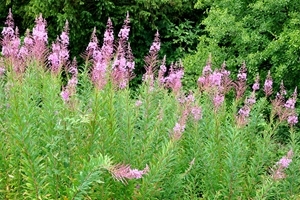Rosebay willowherb
 Many folk can currently be found watching World Cup football on the television, no doubt with beer in hand. However, in the host country Russia, although I’m quite sure many will have a vodka in hand, some may well be sipping Ivan Chai or Koporye tea made from rosebay willowherb (Chamerion angustifolium).
Many folk can currently be found watching World Cup football on the television, no doubt with beer in hand. However, in the host country Russia, although I’m quite sure many will have a vodka in hand, some may well be sipping Ivan Chai or Koporye tea made from rosebay willowherb (Chamerion angustifolium).
The leaves of this plant have been used since the 12th Century to produce tea, as they can undergo fermentation much like real tea. Apparently the tea has a pleasant aroma and fresh, slightly tart taste. It also does not contain caffeine, so that the tea has a calming effect and therefore is good to drink before going off to bed.
At one point in time, rosebay willowherb was all the rage in Britain. Its taste is reported to have been more popular than the classic black tea in the late 19th Century, but the reasons for it falling out of fashion are less clear. Russian sources claim that the East India Company began a targeted smear campaign against ‘Ivan’s tea’. The aim was to discredit the delicious Russian brew so as to remove it as a competitor from the British market. Others point to the collapsing of commercial production in Russia as a result of the Russian Revolution. Either way, nowadays, Koporye tea, or Ivan’s tea, remains something of a hidden treasure, but it can still be bought online!
In North America the plant is commonly known as fireweed, as it often appears after forest fires and other events that leave the earth scorched. Likewise, here in the UK, rosebay willowherb is a pioneer plant, which thrives on waste ground. It likes to grow in dry, relatively open areas such as woodland clearings, alongside railway lines and on recently disturbed ground such as building sites.
This tendency to appear from scorched earth meant that the two times it “turned London pink” were after the Great Fire of 1666 and again after the Blitz, as the plant quickly populated derelict bomb sites. This gave rise to the name bombweed and also ‘London Pride’. Indeed, the plant has been chosen as the county flower to represent London.
Rosebay willowherb flowers over a long period of time – from June to September. After flowering, long seed pods form, containing masses of white fluffy seeds, which are then carried away on the wind. Children out at play on a windy day would catch these fluffy seeds as they floated past, as it was considered lucky to catch one and you could also make a wish as you clutched the seeds in your hand. You can see why the plant establishes itself so quickly on newly disturbed sites, as each plant can produce around 80,000 seeds.
One of my favourite moths, the vividly coloured pink and lime green elephant hawk moth’s caterpillars feed on this plant. The caterpillar can grow as long as a man’s finger, and looks quite like an elephant’s trunk (hence the name). When alarmed, the caterpillar retracts its head to display a pair of enormous ‘false eyes’, giving it a snake-like appearance to deter predators. The caterpillars tend to feed at night time, so look out for them at dusk or a little later on with a torch!
Finally, should you find yourself out on a long walk and in need of a pick-me-up, try a little of the raw pith found in the stems of rosebay willowherb, as it is full of sugar. You will certainly feel the benefit to your blood sugar levels not long after taking on a few mouthfuls!
Peter Thompson
Advisory
Read more from Peter Thompson at his blog.

Download Peter Thompson's essential 26-page book, featuring beautiful photography and detailed profiles of Britain's wildlife
Download FREE >